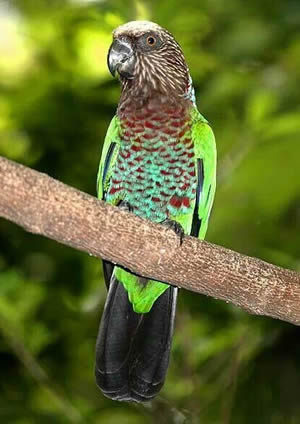Captivity
Hawk headed parrots are generally very active. They love to climb around and are acrobats, and their housing needs in captivity should accommodate this. A macaw or cockatoo size cage with no greater than one-inch bar spacing is appropriate. The cage should not be smaller than 36 inches long by 24 inches wide by 50 inches high. A cage that is too small can contribute to behavioral problems such as aggression. Hawk-heads can be extremely destructive for their size, so a good quality wrought-iron or steel cage is probably the best choice. Of course, even in the largest of cages, hawk-heads need plenty of time out of the cage with their owners.
Summary
Parrots, also known as psittacines, are birds of the roughly 372 species in 86 genera that make up the order Psittaciformes, found in most warm and tropical regions. The order is subdivded in three families: the Psittacidae (true parrots), the Cacatuidae (cockatoos) and the Nestoridae. Parrots have a pan-tropical distribution with several species inhabiting the temperate Southern Hemisphere as well. The greatest diversity of parrots is found in South America and Australia.
Characteristic features of parrots include a strong curved bill, an upright stance, strong legs, and clawed zygodactyl feet. Most parrots are predominantly green, with other bright colors, and some species are multi-colored. Cockatoo species range from mostly white to mostly black, and have a mobile crest of feathers on the top of their heads. Most parrots are monomorphic or minimally sexually dimorphic. Extant species range in size from the Buff-faced Pygmy-parrot, at under 10 g (0.35 oz.) in weight and 8 cm (3.2 inches) in length, to the Hyacinth Macaw, at 1.0 meter (3.3 feet) in length, and the Kakapo, at 4.0 kg (8.8 lbs) in weight. They are the most variably sized bird order in terms of length.
The most important components of most parrots' diets are seeds, nuts, fruit, buds and other plant material, and a few species also eat insects and small animals, and the lories and lorikeets are specialised to feed on nectar from flowers, and soft fruits. Almost all parrots nest in tree holes (or nestboxes in captivity), and lay white eggs from which emerge altricial (helpless) young.
Parrots, along with crows, jays and magpies, are some of the most intelligent birds, and the ability of some parrot species to imitate human voices enhances their popularity as pets. Trapping of wild parrots for the pet trade, as well as other hunting, habitat loss and competition from invasive species, have diminished wild populations, and parrots have been subjected to more exploitation than any other group of birds. Recent conservation measures to conserve the habitats of some of the high-profile charismatic parrot species has also protected many of the less charismatic species living in the ecosystem.






